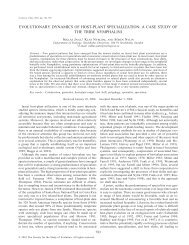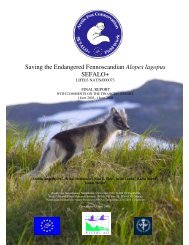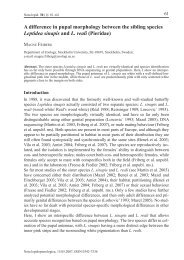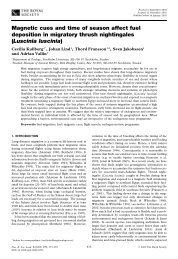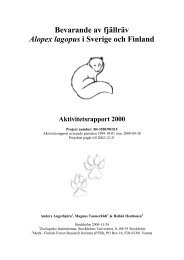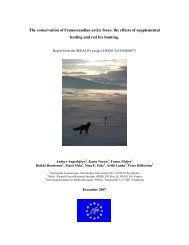Layman's report
Layman's report
Layman's report
You also want an ePaper? Increase the reach of your titles
YUMPU automatically turns print PDFs into web optimized ePapers that Google loves.
Saving the Endangered Fennoscandian<br />
Alopex lagopus<br />
Layman’s <strong>report</strong><br />
LIFE03 NAT/S/000073<br />
Anders Angerbjörn, Tomas Meijer, Nina E. Eide, Heikki Henttonen,<br />
Karin Norén
Preface<br />
The arctic fox Alopex lagopus is threatened with extinction in the European Union and adjacent<br />
areas. It is a priority species according to the Habitat directive. The main threats are the small<br />
population size constrained by low food availability and competition from the larger red fox<br />
(Vulpes vulpes). The EU-Life project SEFALO+ (Save the Endangered Fennoscandian Alopex)<br />
that started in 2003 and finished in 2008 worked towards three main goals;<br />
1) to stop the ongoing population decline of arctic foxes in Fennoscandia<br />
2) to improve the possibility for recovery<br />
3) to double the number of breeding arctic foxes in Fennoscandia within the project<br />
period (2003-2008)<br />
When the first project phase (SEFALO) started in 1998, about 40 adult arctic foxes were present<br />
in Sweden and only five litters were born. During the summer of 2007, 24 arctic fox litters were<br />
born in Sweden and 15 in Norway. Today, there are about 200 individuals in Fennoscandia. The<br />
SEFALO+ project has thus reached the main goal to double the number of breeding arctic<br />
foxes during the project period and has also provided tools for future management of the<br />
Fennoscandian arctic fox population. In this <strong>report</strong>, we summarize the actions and main results<br />
from the project.<br />
Professor Anders Angerbjörn<br />
Stockholm 2008-05-20<br />
Participating organisations<br />
Stockholm<br />
University SU<br />
Swedish<br />
Environmental<br />
Protection Agency<br />
SEPA<br />
County Administration<br />
Board (CAB) of<br />
Jämtland<br />
County Administration<br />
Board of Västerbotten<br />
County<br />
Administration<br />
Board of Norrbotten<br />
Finnish Forest<br />
Research Institute<br />
FFRI<br />
Park and<br />
Forestry Service<br />
PFS<br />
Norwegian Institute for<br />
Nature Research NINA<br />
Swedish University of<br />
Agricultural Science SLU<br />
Swedish National<br />
Veterinary Institute<br />
NVI<br />
Lapplandsafari AB<br />
Geunja<br />
Fjällhästen AB<br />
Ramundberget<br />
Alpina AB<br />
University of Iceland Fjällräven AB WWF Sweden Dogman EU Life-Nature
The arctic fox (Alopex lagopus)<br />
The arctic fox is a small canid (3-5 Kg) inhabiting the arctic tundra. It has a circumpolar<br />
distribution in the northern hemisphere and its global population size reaches more than<br />
100 000 individuals. On a global scale, the arctic fox is thus a commonly occurring species, but<br />
in Fennoscandia and some of the Bering islands, it is classified as critically endangered.<br />
The arctic fox can be divided into two different ecotypes, the ´lemming fox´ and ´the coastal<br />
fox´. Lemming foxes live in Fennoscandia, North America, Canada and parts of Greenland<br />
whereas coastal foxes are found in Iceland, Svalbard and Greenland. The coastal fox mainly<br />
feed on sea birds, seal carcasses and fish. Most arctic foxes are however lemming foxes,<br />
meaning that they mainly feed on lemmings and other rodents but also on ptarmigan,<br />
passerines and carcasses. Lemming foxes can migrate long distances (>1000 km) over the sea<br />
ice, whereas coastal foxes are more stationary.<br />
For successful reproduction, the lemming fox is highly dependent on the rodent availability,<br />
especially the lemmings. The lemmings are highly fluctuating in numbers with peaks every 3-4<br />
year (lemming years), which is also reflected by the arctic fox reproductive output. During a<br />
lemming peak, an arctic fox female can give birth to up to 20 cubs, but during the low phase<br />
few or no cubs are born and many females fail to reproduce. The mortality is also dependent<br />
on the lemming cycle with a higher survival during years with high density of lemmings. The<br />
juvenile mortality can be as high as 90% during their first year if the lemming abundance is<br />
low. Coastal foxes, on the other hand, generally gives birth the about 6-8 cubseach year, which<br />
most likely is an adaptation the stable access to food in marine environments.<br />
Figure 1. A. White arctic fox in winter fur. B. White arctic fox in summer fur. C. Blue and white<br />
colour morphs. Photo: Tomas Meijer, Peter Hellström<br />
The arctic fox occurs in two distinct colour morphs, ´white´ and ´blue´ (Figure 1). The white<br />
morph is almost entirely white during winter and grey during summer. The blue morph is<br />
chocolate brown during summer and dark blue or black during winter. The two colour morph<br />
breed freely with each other and both morphs can be represented in the same litter. Globally,<br />
about 95 % of the arctic foxes belong to the white colour morph. The blue colour morph is<br />
more common in coastal habitats, probably due its camouflaging advantage.
The arctic fox lives in dens, situated in tundra soil or in rocky areas. One den site can be used<br />
for several generations and the tundra soil dens can have up to 100 entrances. Den sites are of<br />
particular importance during cub rearing (May-August). Both the male and the female<br />
participate in cub rearing and spend a large amount of time at or nearby their den. During<br />
winter, however, the arctic fox is free-ranging and spend less time on dens.<br />
Figure 2. A. Rock ptarmigan (Lagopus mutus) B. Lemming (Lemmus lemmus) C. Passerine<br />
(Calidris alpina) Photo: Tomas Meijer<br />
The arctic fox in Fennoscandia<br />
In mainland Europe, the arctic fox is found above the tree line in the mountain tundra of<br />
Fennoscandia (Sweden, Finland, Norway and the Kola Peninsula). It was one of the first<br />
mammal species to colonize Fennoscandia after the last ice age and is well-known for its<br />
fluctuating population size due to the lemming cycle. Historically, the arctic fox was a<br />
commonly occurring species with breeding populations reaching at least 15 000 individuals in<br />
lemming peak years during the mid-19 th century. However, it suffered a drastic decline due to<br />
over-harvesting by the fur industry at the beginning of the 20 th century.<br />
Trading with arctic fox fur became profitable and in 1925, prices could reach 1000 SEK for<br />
beautiful specimen of fur. Despite legal protection since 1928 in Sweden, 1930 in Norway and<br />
1940 in Finland, the population has remained at a low density for over 80 years.
100<br />
80<br />
Reproducing a dult arctic foxes<br />
60<br />
40<br />
20<br />
SEFALO<br />
SEFALO+<br />
0<br />
1983 1986 1989 1992 1995 1998 2001 2004 2007<br />
Figure 3. Number of reproducing arctic foxes in Sweden 1983-2007<br />
When the first project phase (SEFALO) started in 1998, about 40 adult arctic foxes were present<br />
in Sweden and only five litters were born. SEFALO (1998-2002) was a joint arctic fox<br />
Year<br />
conservation project between Sweden and Finland, financed by EU-Life. In 2003, the second<br />
phase of the project, SEFALO+ (2003-2008) started and Norway was also included.<br />
Today, there are about 200 arctic foxes, distributed in four geographically separated areas<br />
(Figure 4); Helagsfjällen (C), Borgafjäll/ Børgefjell (B) and Northern Fennoscandia (A) which<br />
includes all mountain tundra areas north of Vindelfjällen up to Finnmark. Between these<br />
populations, the migration rate is very low or absent. In southern Norway, Finse (D), there is<br />
remnants of a wild population that is genetically mixed with farm bred arctic foxes.
Figure 4. The blue colures indicate mountain areas that inhabit arctic foxes. A. Northern<br />
Fennoscandia including the Kola peninsula. B. Borgafjäll/Børgefjell C. Helagsfjällen D. Finse<br />
Threats, actions and results<br />
Several factors may have contributed to the non-recovery of the arctic fox after the severe<br />
population decline in the beginning of the 20 th century. The SEFALO+ project has focused to<br />
stop the population decline of the Fennoscandian arctic fox and improve the chances for long<br />
term survival. The conservation actions have focused to diminish the major threats;<br />
Food scarcity and red fox interactions<br />
One of the most prominent factors is food scarcity due to irregularities in the lemming cycle.<br />
During 1930-1950, the lemming cycles disappeared, which caused a further population decline.<br />
After 1950, when the lemming cycle returned, the population slowly increased, but during 1980-<br />
2000, the lemming cycle was absent again and the arctic fox population declined again. During<br />
the project period, we have supplied dens with litters with extra food, usually with the<br />
commercial dog pellet, Dogman dinner (Figure 6). During wintertime, carcasses have been<br />
hidden under the snow as a complement to the dog pellets. With supplementary feeding at<br />
dens during summers, juvenile arctic foxes survive better. Extra food during wintertime<br />
increases the number of breeding arctic fox pairs, larger litters and higher juvenile survival<br />
which contributes to a faster population growth.
Figure 5. The red fox weight about 5-11kg (arctic fox 3-5kg) and can chase away and kill both<br />
adult and juvenile arctic foxes. Photo: Tomas Meijer<br />
In addition, the red fox has increased in numbers on the mountain tundra. The red fox (Figure<br />
5) is almost twice the size of an arctic fox and compete with the arctic fox both about territories<br />
and den sites. Red foxes have also been observed both killing and chasing away arctic foxes<br />
from den sites. Red foxes have been culled by hunters with special license or by county board<br />
administration personnel using snowmobiles. This is a very efficient method to reduce the<br />
number of red foxes on the mountain tundra. All hunting has been performed to minimize<br />
suffer with respect to ethical consideration and disturbance of other wildlife. On average,<br />
during the project period, about 100 red foxes have been culled in Sweden and 180 in Finland.<br />
External feeding stations can also attract the larger red fox and must therefore always be<br />
combined with red fox culling.<br />
Small population<br />
The small population itself is also a threat. Foxes have difficulties finding a non-related partner<br />
conveying in fewer number of breeding events and a slower population growth. In small<br />
populations, genetic factors may be of particular importance. Genetic analyses have shown<br />
that the population decline in the early 20 th century caused loss of genetic variation and that<br />
the degree of diversity is lower in the southern populations than in the north. Low genetic<br />
variation may decrease the possibilities for future adaptation to changes in environmental<br />
factors, such as climate change. Due to the high proportion of relatives in each population,<br />
there is a high risk of negative effects due to inbreeding (mating between close relatives). To<br />
increase population viability and evolutionary potential as well as decrease inbreeding,<br />
migration between populations or actively exchanging individuals between the populations will<br />
be necessary in the future.
Figure 6. A feeding station designed for Dogman Dinner dog pellets. Photo: Tomas Meijer<br />
The small population size also implies that even small changes in demographic parameters or<br />
pure "accidents" can affect the risk of extinction dramatically. Diseases may be a further<br />
important factor, especially in small populations. Concerns have been raised about a fatal<br />
disease that has caused high mortality among arctic foxes in captivity, which may impact<br />
heavily on such a small population. The disease that caused mass mortality among arctic<br />
foxes in captivity has been identified as a form of herpes virus. This virus has not been<br />
identified among wild arctic foxes and is not assumed to be a threat to the wild population.<br />
However, it is important to avoid future contact between wild arctic foxes and foxes in captivity<br />
to avoid spreading of diseases.<br />
Hybridisation with escaped farm foxes<br />
Another possible threat to the arctic fox is the occurrence of escaped farm foxes on the<br />
mountain tundra. Since farmed arctic foxes mainly are imported from coastal areas and have<br />
been bred in captivity for several generations, they deviate from wild arctic foxes in numerous<br />
characters. Breeding with wild arctic foxes can lead to loss of local adaptations to the<br />
Fennoscandian environment and thereby lower the chance of long term survival.<br />
Genetic analyses have revealed several escaped farm foxes in the wild as well as possible<br />
hybrids between wild and farmed arctic foxes. In Finse (D, Figure 4), no pure wild arctic foxes<br />
remain and all foxes are either pure farmed foxes or hybrids. SEFALO+ strongly recommends<br />
that foxes of farmed origin are removed to prevent dispersal events into populations with pure<br />
wild arctic foxes.
Disturbance<br />
Another issue is disturbance from tourists and free-ranging dogs that may influence arctic fox<br />
behaviour, especially during spring and summer when the arctic fox is highly dependent on<br />
dens for successful reproduction. In order to minimise disturbance around dens with cubs, the<br />
area surrounding the den has been protected from ptarmigan game hunting that is common in<br />
most areas and is conducted with free-ranging dogs. Since free-ranging dogs are considered<br />
to disturb arctic foxes severely, this has been a prioritised action. Further, dogs have been<br />
documented killing arctic foxes and there has also been a case where a hunter shot an arctic<br />
fox believing it was a mountain hare<br />
To minimise disturbance from humans, information regarding arctic fox biology and status<br />
have been an important component of SEFALO+. The project has worked in several ways to<br />
provide information both to the scientific society and the public. In total, 43 lectures open to<br />
public has been held and 22 articles in magazines and news papers, and 26 articles in scientific<br />
papers have been published during the project period. Information has also been provided<br />
through television, radio and other arrangements.<br />
Figure 7. A juvenile arctic fox that weights<br />
about 1300g. The plastic ear tags can be<br />
seen in the left ear. Photo: Helena<br />
Forslund.
Project results<br />
To sum up, the Fennoscandian arctic fox population declined between 1983- 2000, but has<br />
increased since then (Figure X). Analyses have shown that the population increase is due to a<br />
combination of lemming density and the SEFALO+ actions red fox culling and supplementary<br />
feeding during winter.<br />
In Helags and Borgafjäll, the actions have been conducted with a particular high intensity and<br />
the number of litters has more than doubled during the project period (Figure 8). In comparable<br />
areas with lower intensity of actions, i.e. Vindelfjällen and Norrbotten, the number of litters has<br />
been stable or decreased (Figure 6). Even though the populations in Helags and Borgafjäll<br />
have responded well to the actions, the population is still too small for long-term survival. The<br />
main problem is that the different subpopulations are genetically isolated from each other and<br />
the arctic foxes within a subpopulation are closely related. SEFALO+ therefore recommend<br />
that the actions should continue with the same intensity as during the project period and that<br />
arctic foxes are translocated between the subpopulations to improve the genetic situation.<br />
Figure 8. Number of arctic fox litters during years with increasing numbers of rodents. A.<br />
Børgefjell*** B. Norbotten** C. Vindelfjällen**. D. Helagsfjällen* D. Borgafjäll*. Area with high<br />
intensity of actions *, area with no actions *, area with low intensity of actions **.<br />
In Finland, no litters have been <strong>report</strong>ed during the project period, despite a high intensity of<br />
red fox culling. This probably depends on that the breeding arctic foxes were extinct in Finland<br />
already when the actions started. However, sporadic arctic fox observations have been<br />
<strong>report</strong>ed from Finland and since arctic foxes are present in Finmark, northern Norway,<br />
migration into Finland is possible.
This project has shown that a combination of actions can stop the decline of the<br />
Fennoscandian arctic fox population. 2007 was a record year with 39 arctic fox litters and for<br />
the summer 2008, we predict a further increase in numbers. However, the number of arctic<br />
foxes present today (c. 200 individuals) is too low for long-term persistence. To reach a further<br />
population increase, the SEFALO+ conservation actions need to be continued with the same<br />
intensity as during the project period and be combined with translocation to increase the<br />
genetic variability within the subpopulations. With efficient management of the Fennoscandian<br />
arctic fox population, the coming generations will be able to enjoy the view of wild arctic foxes<br />
on the mountain tundra.<br />
www.zoologi.su.se/research/alopex



